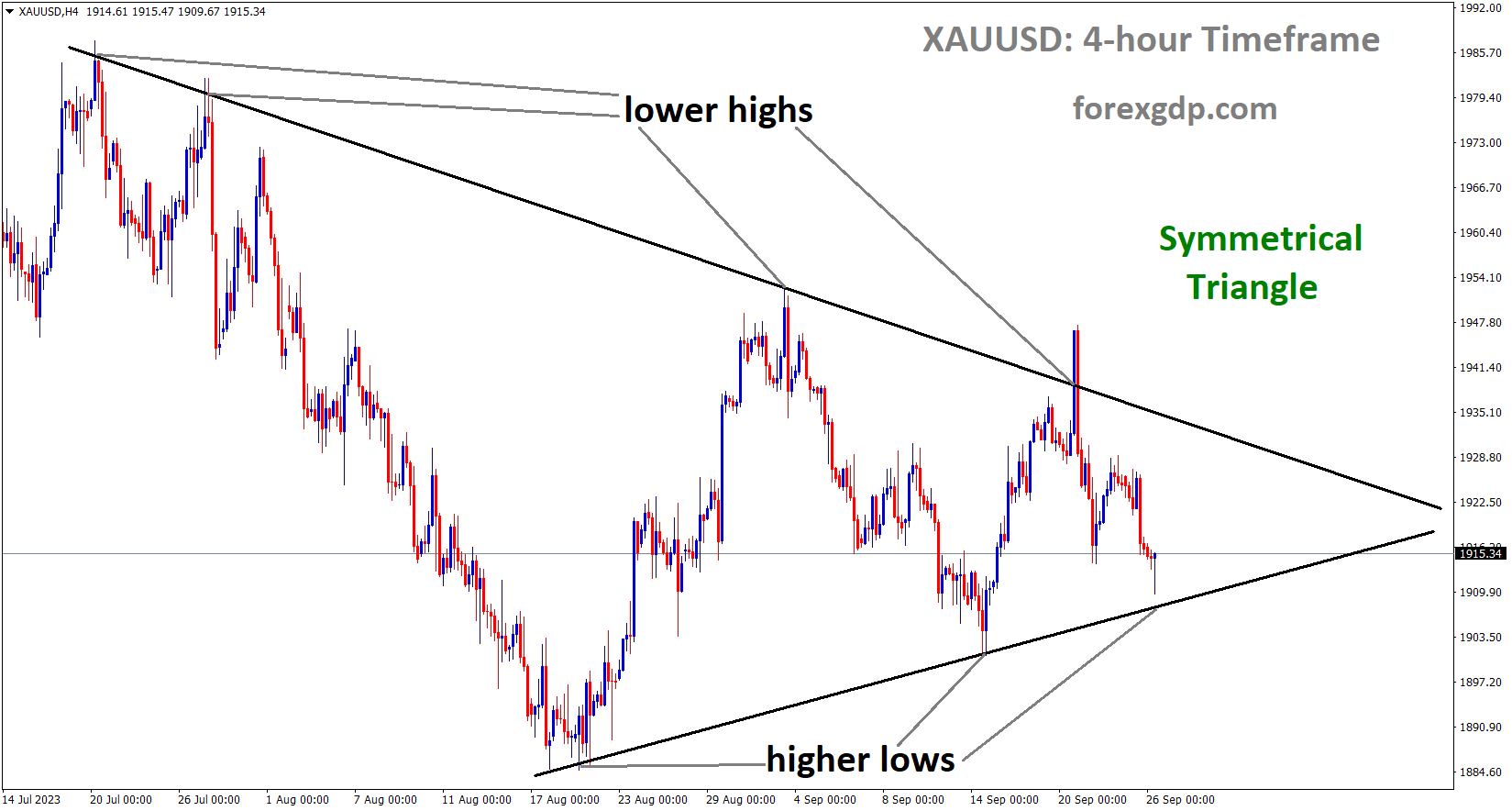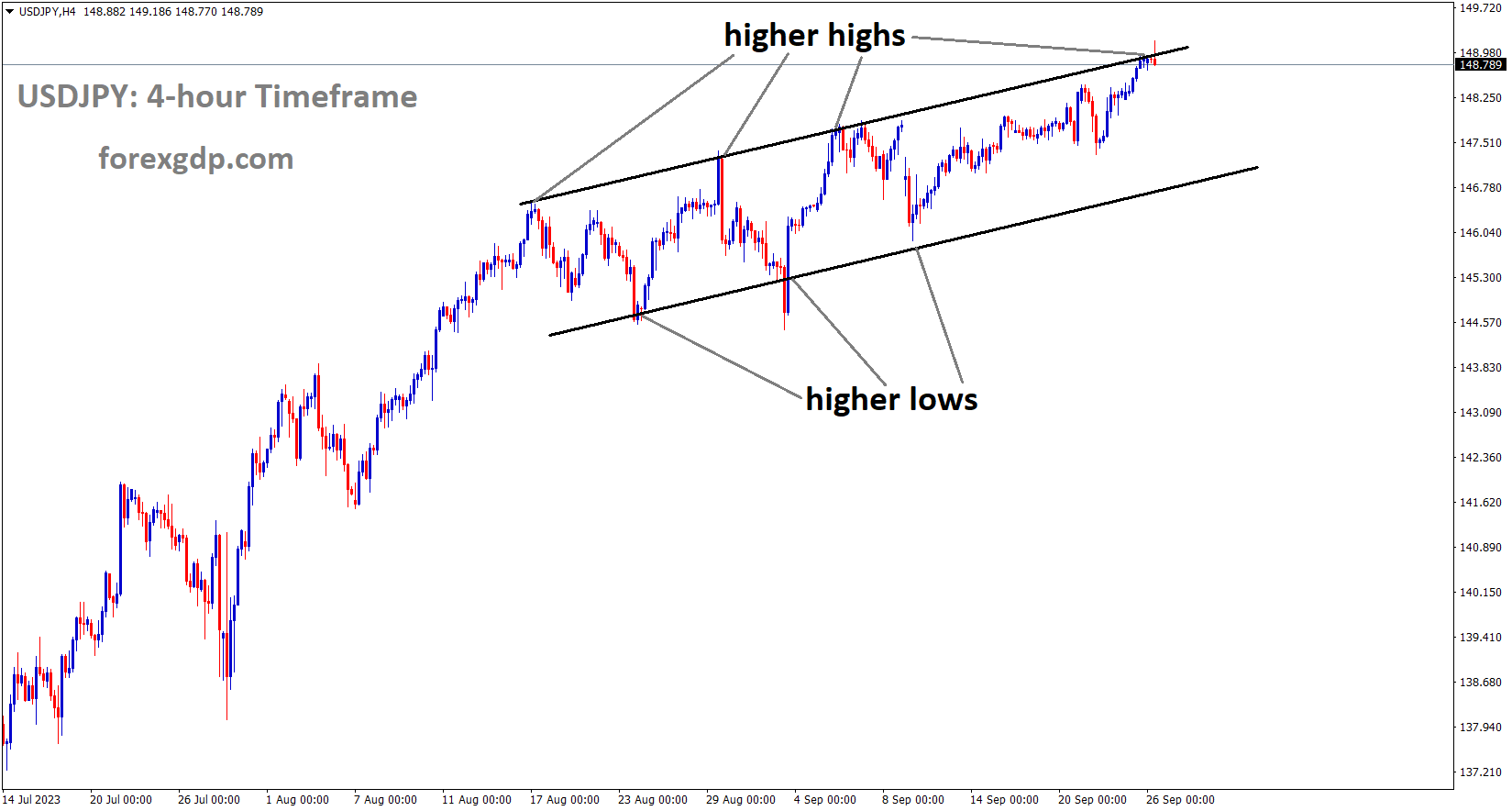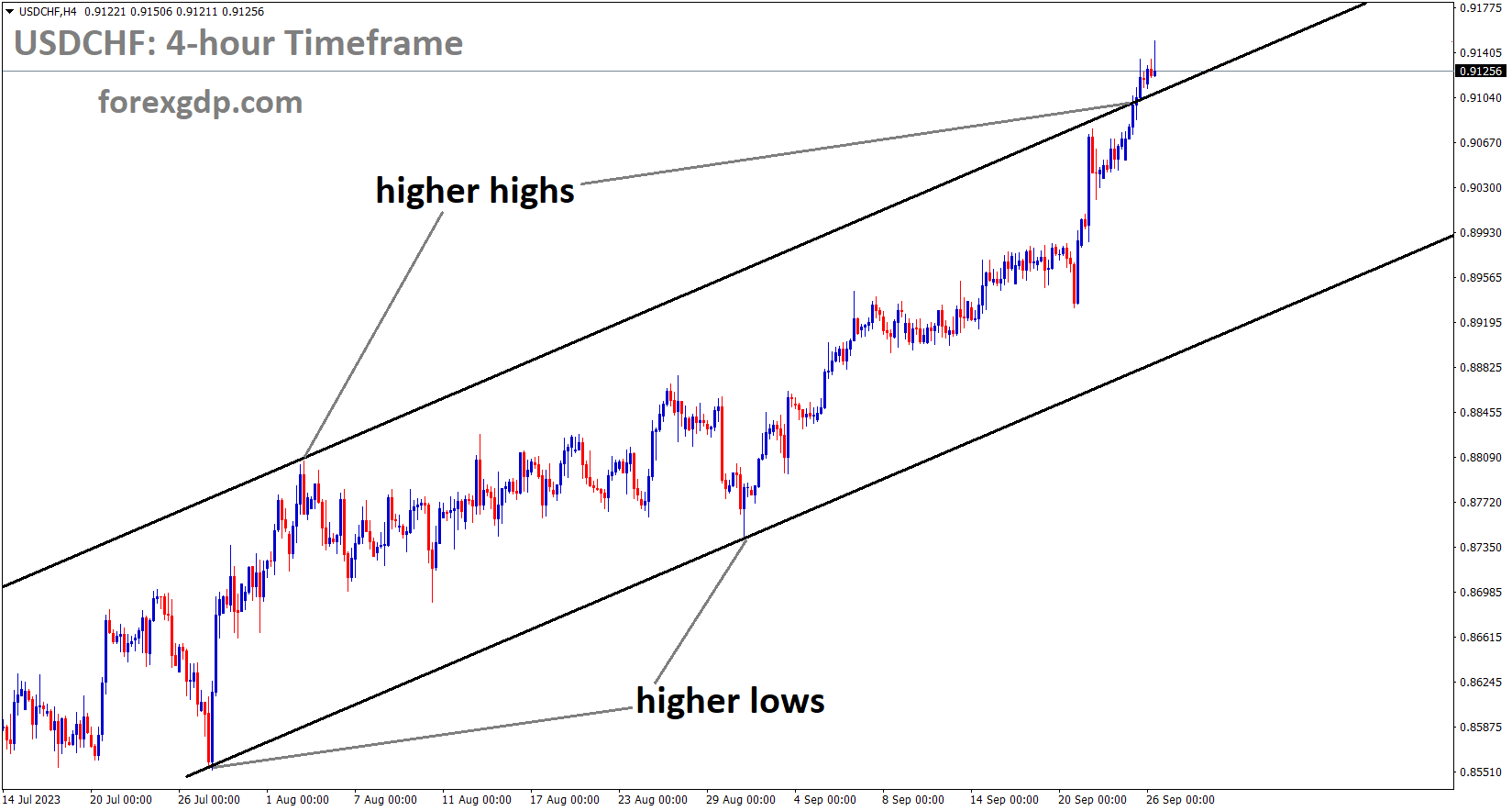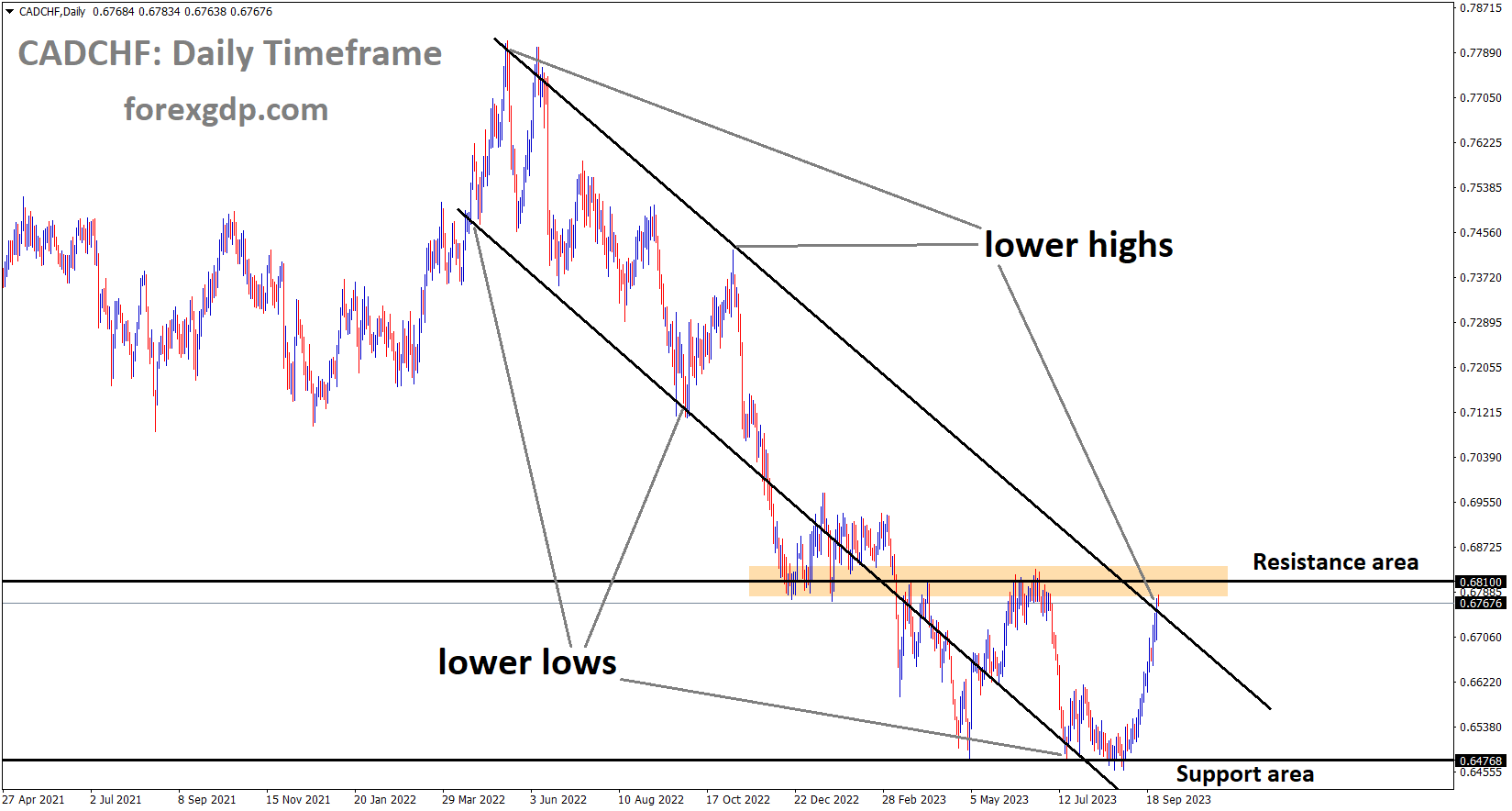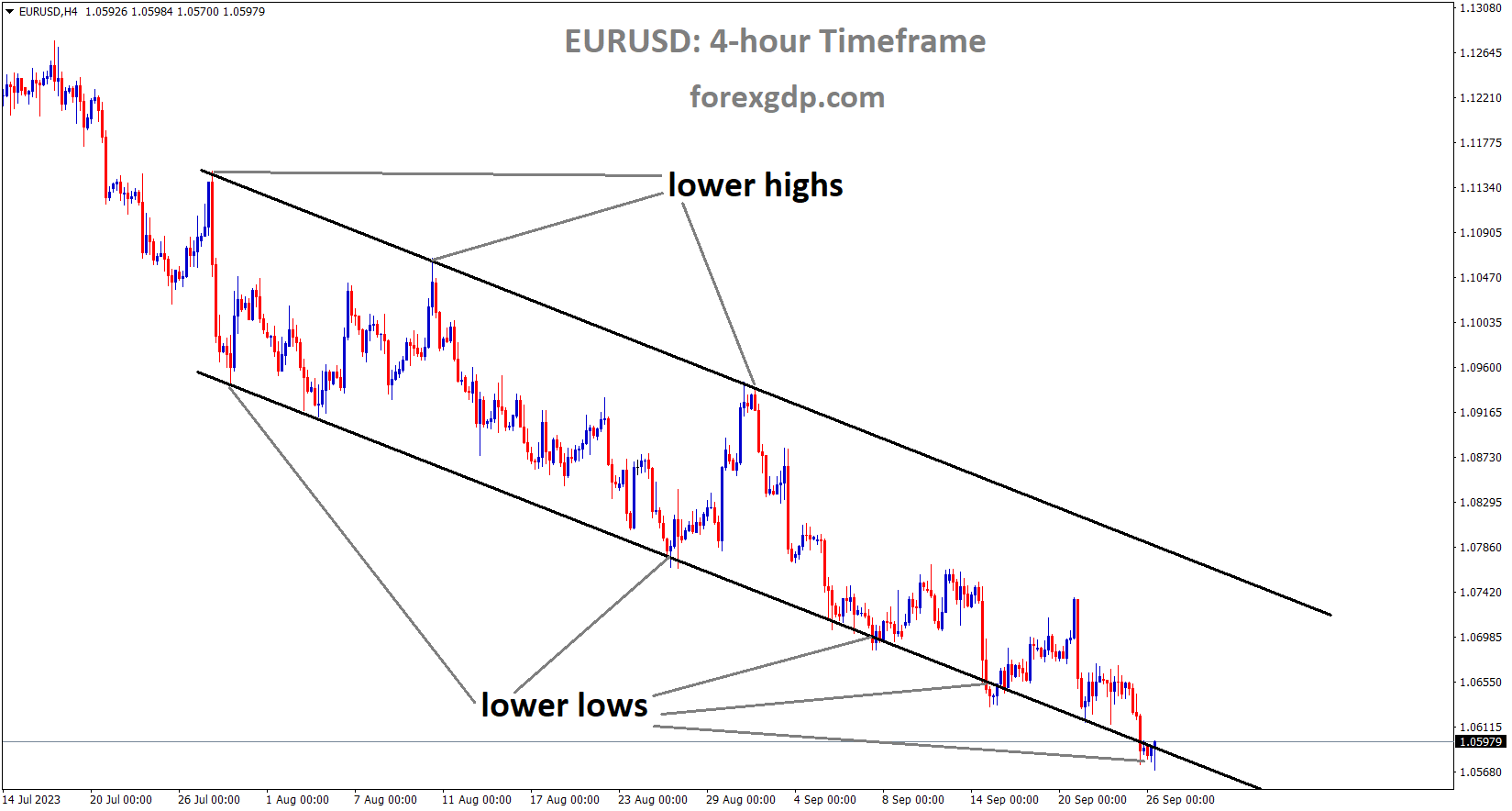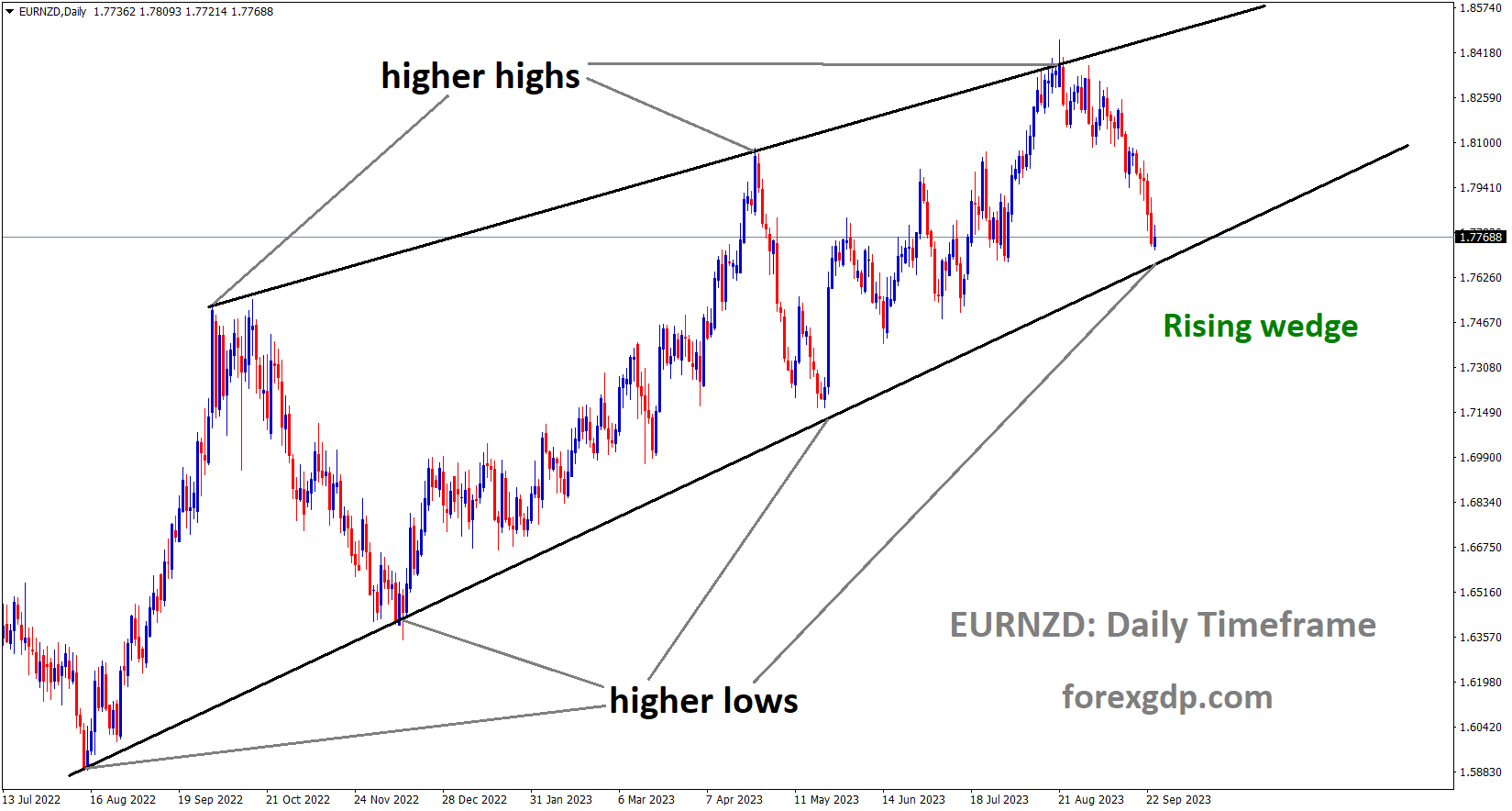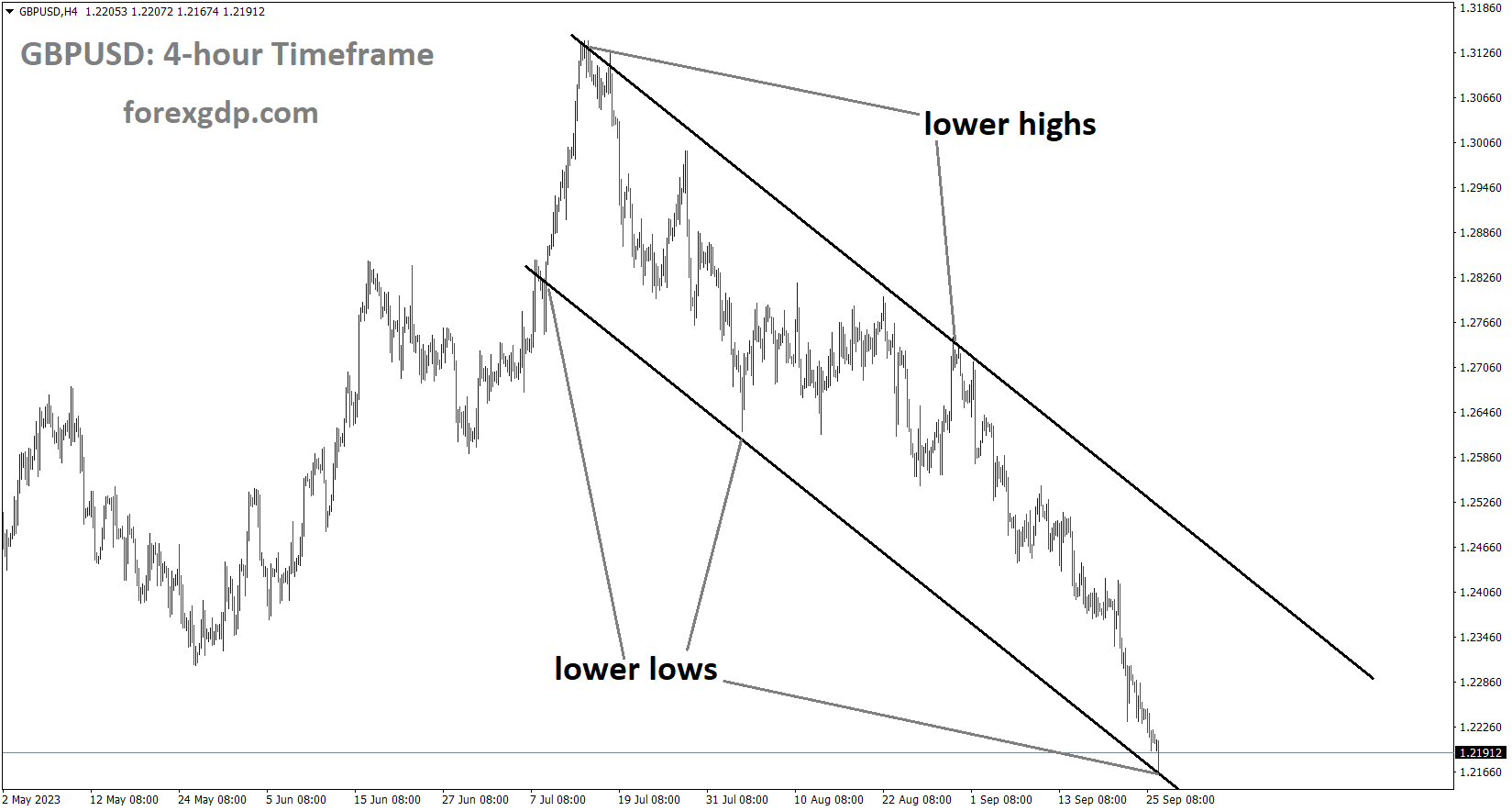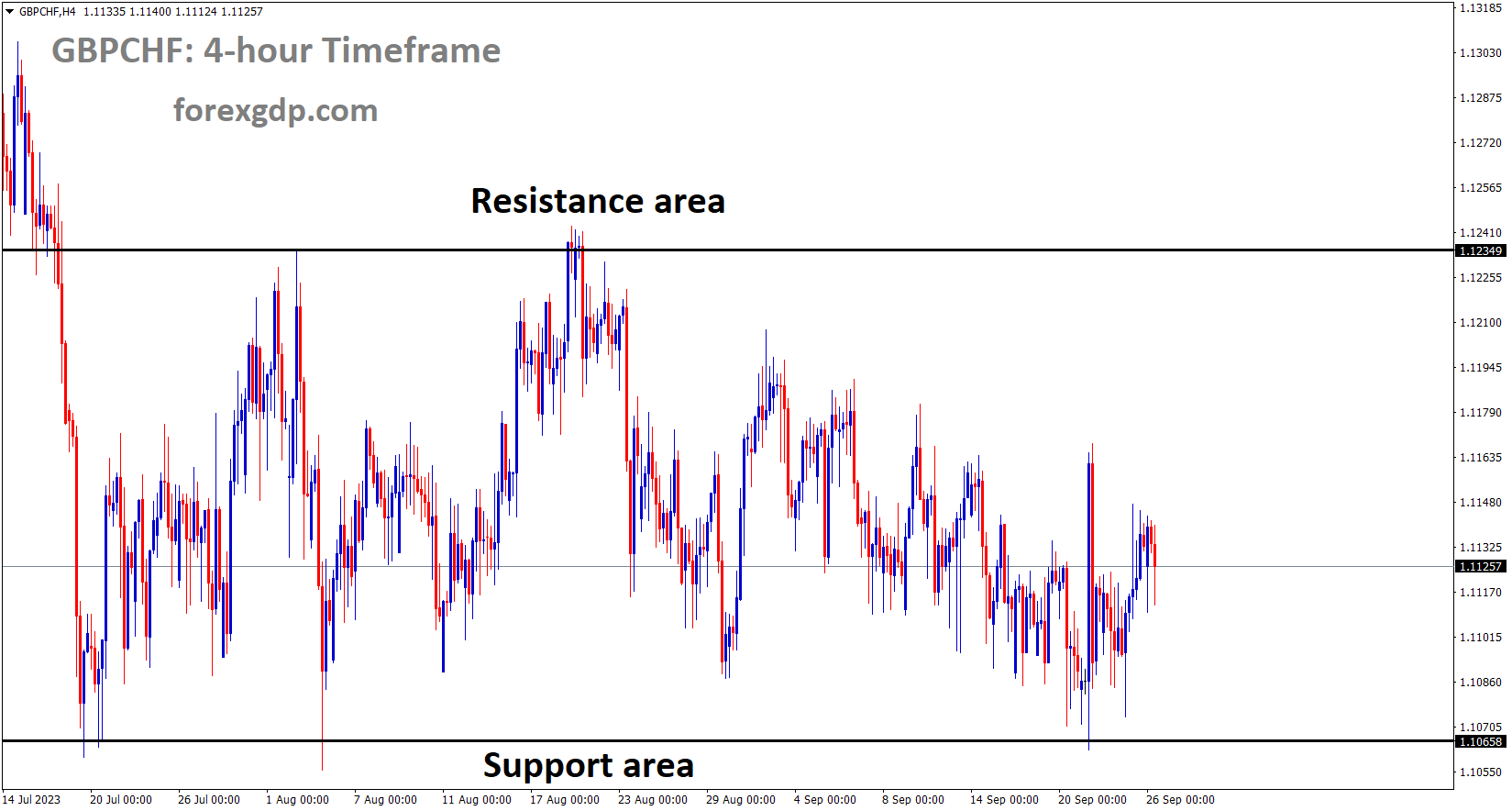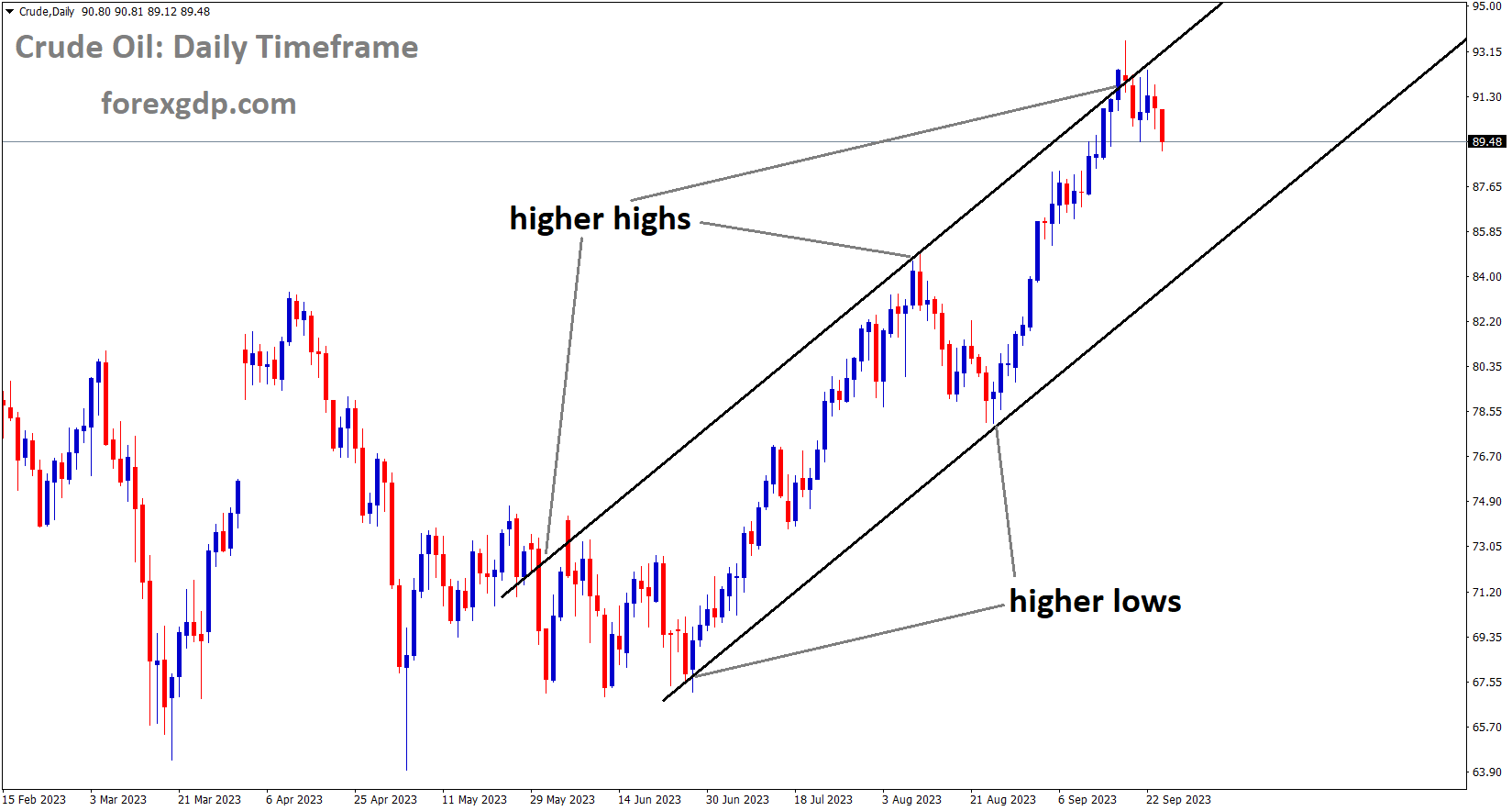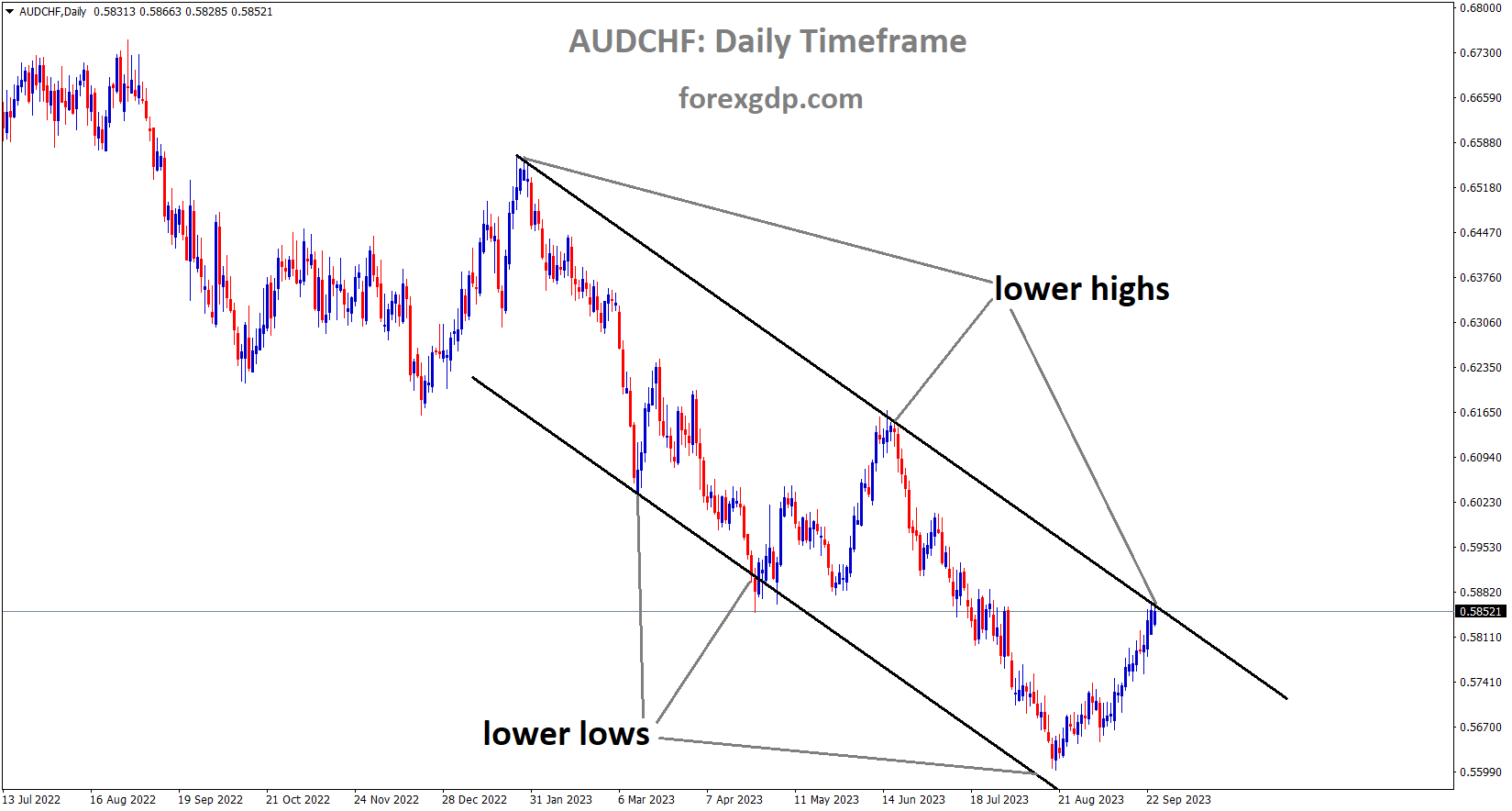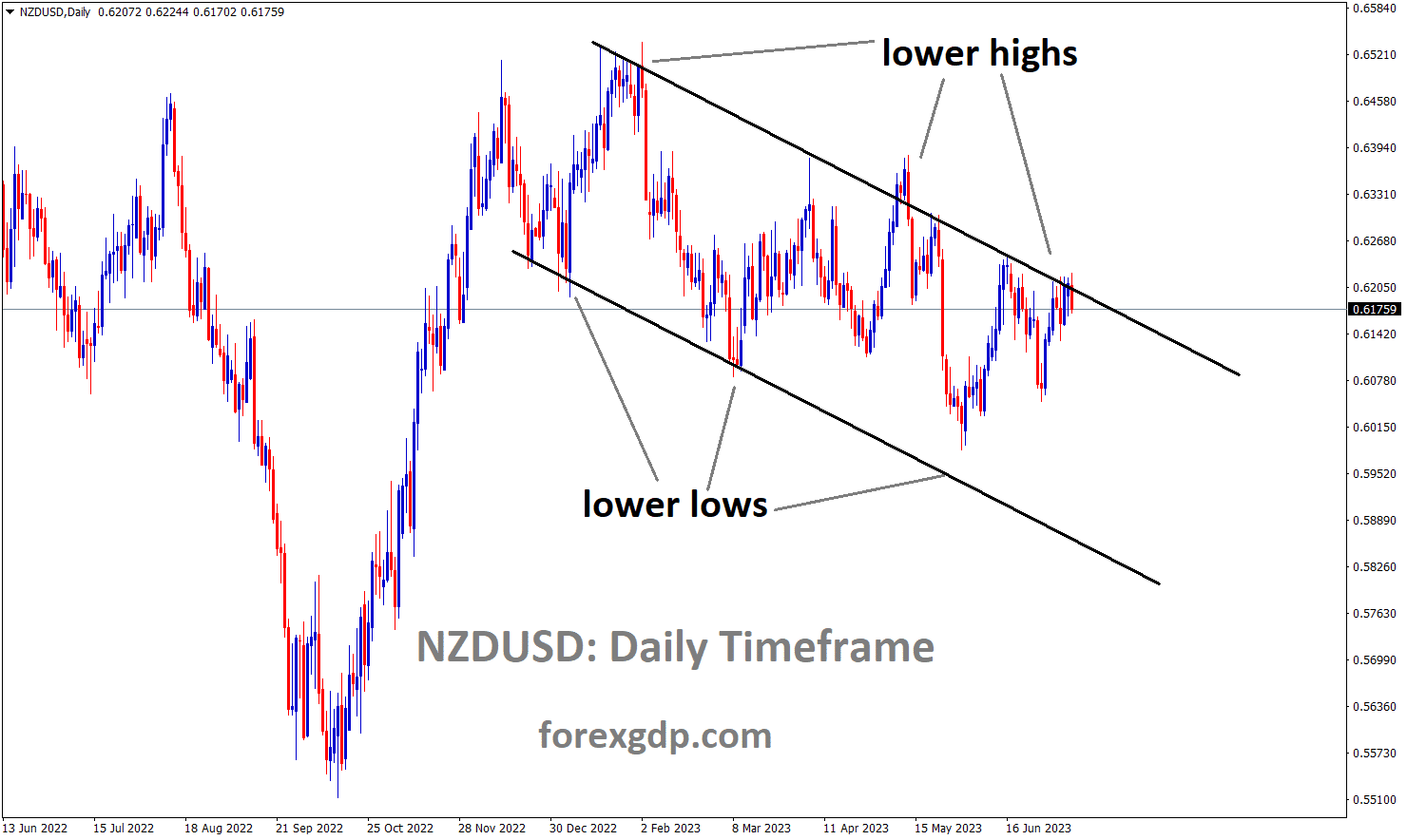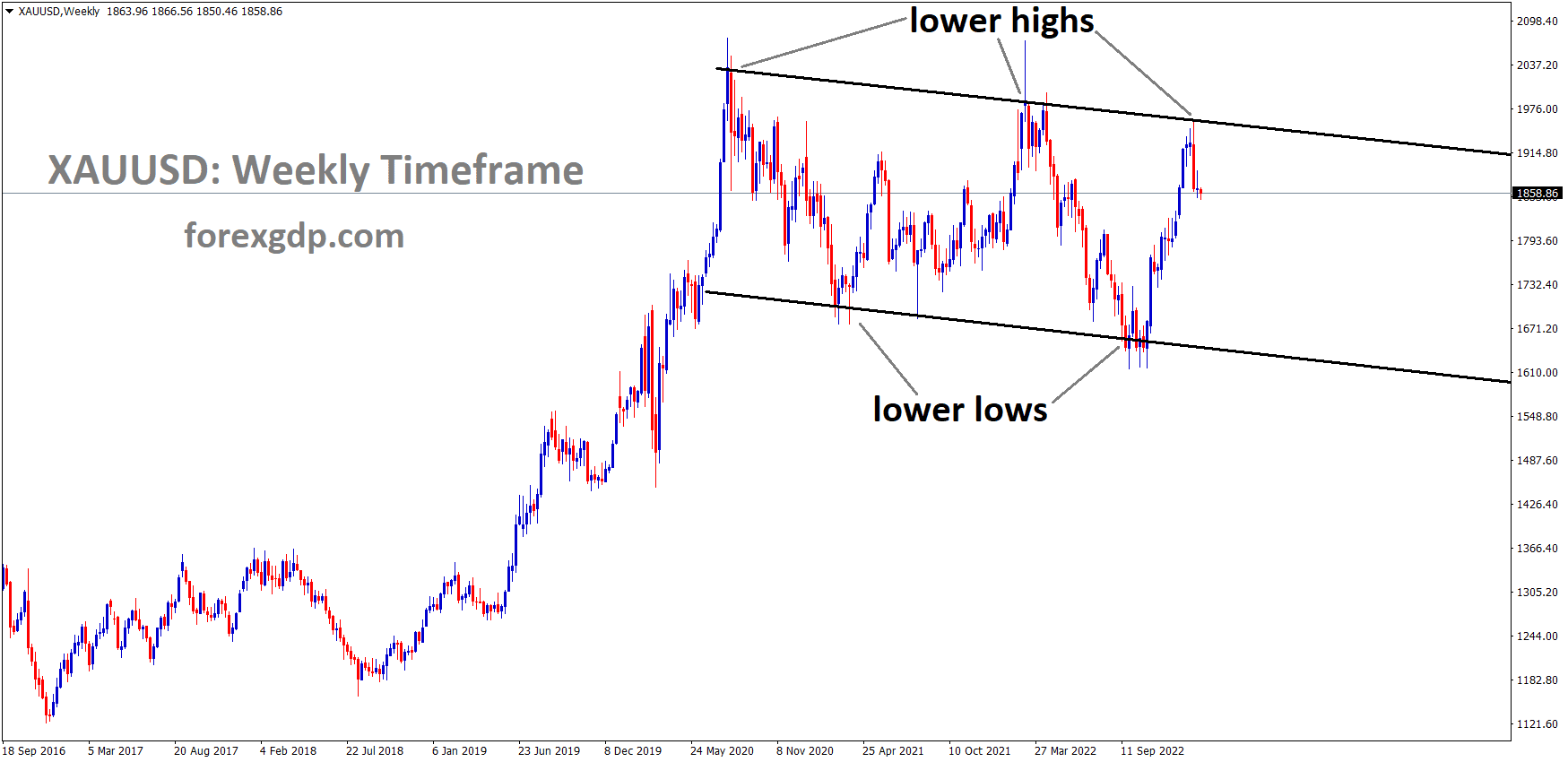GOLD Analysis
XAUUSD Gold price is moving in the Symmetrical triangle pattern and the market has reached the bottom area of the pattern.
Concern for gold assets arises from the FED’s expanding stance on interest rates. Growing rates of gold locker deposits force the market’s non-yielding asset sales.
Gold prices withstood the hawkish signal from the Fed during the most recent meeting. TD Securities strategists assess the prospects for the yellow metal. Chair Powell surprised everyone by reinforcing the higher for longer narrative, which has been the biggest source of concern for Gold bugs.

The economic data in the future will be crucial in determining Golds course. Simultaneously, robust physical markets function as a counterbalance to conventional macroeconomic relationships, highlighting the yellow metals prices ability to withstand the substantial increase in yields.
USDJPY Analysis
USDJPY is moving in the Ascending channel and the market has reached the higher high area of the channel
According to the Japanese Cabinet Office, corporate profits have increased for the first time since 2022 and the country’s economy is performing somewhat better each month.
The Japanese Cabinet Office kept the general assessment of the economy for September, stating that it is recovering moderately, in its monthly assessment report. For the first time since March 2022, Japan raised its opinion on corporate profits in September, claiming that things are improving as a whole, according to the report.
USDCHF Analysis
USDCHF is moving in the Ascending channel and the market has reached the higher high area of the channel
The Swiss Franc lost value relative to counter pairs last week when “SNB” decided to pause the rate hike. The Swiss franc is less valuable than the US dollar if the US Federal Reserve continues to hike interest rates in 2023.
The pair USDCHF consolidates its recent strong gains to reach its highest point since late May, which it touched the day before. On Tuesday during the Asian session, it fluctuates within a small range. Spot values are presently trading in the 0.9125 range and appear ready to continue their upward trajectory that began two months ago. The markets were taken aback last Thursday when the Swiss National Bank SNB announced that it would halt its cycle of rate hikes for the first time since March 2022, citing a decline in inflation. This further weakens the Swiss Franc CHF, which is seen to be acting as a tailwind for the USDCHF pair along with the general bullish sentiment surrounding the US Dollar USD.

In actuality, the Federal Reserve’s Fed hawkish outlook continues to provide strong support for the USD Index DXY, which measures the Greenback against a basket of currencies, as it held steady at the 10-month high touched on Monday. The US Federal Reserve restated its story of higher interest rates for longer periods of time and issued a warning that at least one more rate hike by the end of the year was probably in store due to persistently high inflation. Moreover, investors are becoming more and more cautious due to concerns about the possible inflationary effect of growing oil prices. This should enable the Fed to maintain its hawkish stance, in conjunction with the robust US macro data that is coming in. As a result of the outlook, the US fixed-income market experiences a prolonged selloff, which raises the yield on the rate-sensitive two-year government bond to its highest level since 2006.
CADCHF Analysis
CADCHF is moving in the Descending channel and the market has reached the lower high area of the channel
Beyond the 4.50% barrier, the benchmark 10-year US Treasury yield rises to a 16-year high and keeps supporting the Greenback. Having said that, traders are being prevented from making new bullish wagers on the USDCHF pair by the extremely overbought Relative Strength Index RSI on the daily chart. Conversely, the recent breakout through a technically significant 200-day Simple Moving Average SMA indicates that any meaningful corrective pullback is more likely to be bought into and that the path of least resistance for spot prices is to the upside. Investors are now focusing on the US economic calendar, which includes the release of the Richmond Manufacturing Index, New Home Sales, and the Conference Board’s Consumer Confidence Index. This will affect the dynamics of the USD price and create opportunities for short trading the USDCHF pair, along with the yields on US bonds. However, bulls may hold off on positioning for any additional appreciating move until there is some short-term consolidation.
EURUSD Analysis
EURUSD is moving in the Descending channel and the market has reached the lower low area of the channel
Members of the ECB Board felt that if interest rates remain normal, euro inflation will soon surpass the inflation target.
Interest rate differences between the FED and the ECB, as well as domestic data, are the primary drivers of the dollar’s strength. As interest rates dropped, the value of the US dollar steadily declined.
Around the European Central Bank , new Board members discovered consensus after an earlier trend towards a possible protracted deadlock in its rate-hike cycle, even though inflation remained well above the bank’s objective. The Conference Board’s Consumer Confidence Index, New Home Sales, the FHFA’s House Price Index, and the speech by Michelle Bowman, the FOMC’s permanent voter (hawk), will be the main items on the US docket. The drop against the USD is prolonged by the EUR. Yields in the US and Germany move through the region of multi-year peaks. By the end of 2023, markets anticipate a 25 basis point rate hike from the Fed. Investors anticipate possible Fed interest rate reductions in Q3 2024. The ECB’s pause talks are still gaining traction. Fears of intervention are present in the price movement of the USDJPY.

Financial disparity is driving the EURUSD exchange rate higher. From Commerzbank’s perspective, the growth outlook is likely to be crucial. Bettors who anticipate sustained strength or even appreciation in the US dollar should be aware that they are placing a wager on the US economy’s performance, making the dollar more vulnerable to negative economic news. Because a lot of US optimism appears to be priced into the USD, we continue to see the possibility of a correction of the current Dollar strength against this backdrop. Nonetheless, the probability of this occurring diminishes as indications of the widening economic gap between the US and the Eurozone grow.
EURNZD Analysis
EURNZD is moving in the Rising wedge pattern and the market has reached the higher low area of the pattern
Due to the country’s high rate of job loss, there is less demand for new homes, which is causing difficulties for China’s real estate industry. China is bearing the brunt of the deflationary risks. As a result, the NZD Dollar weakens versus counter pairs.
The Kiwi asset corrects as the growing risks of a global slowdown reduce demand for riskier currencies. Due to the worsening demand climate and rising unemployment rate, households in China delayed making new real estate purchases, making the property sector vulnerable. As the economies of Europe are straining under the weight of excessive inflation, the Chinese economy is vulnerable to risks of upside deflation.
New Zealand, the growth rate in the quarter ending in April–June was positive even after the Reserve Bank of New Zealand (RBNZ) raised interest rates. Compared to forecasts of 0.5% growth, the Q2 GDP increased by 0.9%. During the quarter ending in March, the economy did not grow. While it grew at a slower rate of 1.8% annually in Q2 compared to 2.2% in Q1, the Q2 GDP still exceeded forecasts of 1.2% growth.
GBPUSD Analysis
GBPUSD is moving in the Descending channel and the market has reached the lower low area of the channel
The Bank of England paused interest rates last week, and this week the GBP is less strong than counter pairs. GDP economic data is planned for this week.
The US Dollar USD is regarded as a major factor that continues to act as a headwind for the GBPUSD pair and is currently standing tall near the YTD peak set on Monday. During last week’s September policy meeting, the Federal Reserve Fed maintained its hawkish posture and restated the theory of higher-for-longer interest rates. Indeed, by year’s end, at least one more interest rate hike was probably in store due to persistently high inflation, according to the US central bank’s warning. In addition, policymakers anticipate only two rate cuts in 2024 as opposed to the four they had previously predicted.
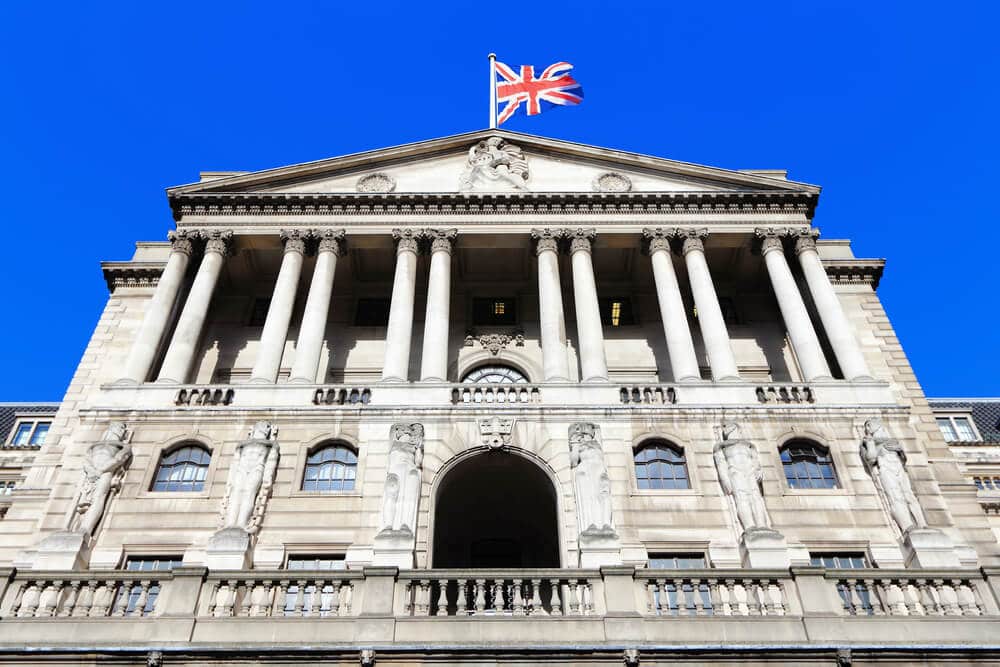
The incoming robust US macro data also raises the possibility of additional policy tightening by the Fed, which supports the Greenback and the recent blowout rally in US Treasury bond yields. For the first time since 2007, the yield on the benchmark 10-year Treasury bond increased above the 4.50% mark, while the yield on the rate-sensitive two-year US government bond reached a 17-year high. In addition to this, the unexpected pause announced by the Bank of England BoE on Thursday appears to be another factor influencing the GBPUSD pair.
GBPCHF Analysis
GBPCHF is moving in the Box pattern and the market has rebounded from the support area of the pattern
After 14 consecutive hikes since December 2021, the UK central bank decided to leave the main policy rate unchanged at a 15-year high of 5.25% in response to the recent slowdown in inflation and indications of slowing economic growth. This in turn strengthens the likelihood that the GBPUSD pair will continue to decline, but bearish traders are prevented from making new bets by the daily chart’s extremely oversold Relative Strength Index RSI. Therefore, it will be wise to hold off on the next leg down until there has been some consolidation or a slight rebound. Due to the lack of any pertinent, market-moving economic data coming out of the UK on Tuesday, the GBPUSD pair is at the whim of the USD price dynamics. In order to seize short-term opportunities later in the early North American session, traders will be watching the US economic docket, which will include the release of the Richmond Manufacturing Index, New Home Sales data, and the Conference Board’s Consumer Confidence Index.
Crude Oil Analysis
Crude Oil price is moving in an Ascending channel and the market has fallen from the higher high area of the channel
The Canadian dollar is receiving strong support from oil prices relative to counter pairs. Because of the Bank of Canada’s continued hawkish stance at the next meeting, the US Federal Reserve’s hawkish stance strengthens the Canadian dollar.
The primary forces behind the pair are the Federal Reserve officials’ hawkish stance and the drop in oil prices. For additional motivation, market participants are awaiting the US Core Personal Consumption Expenditure Price Index data and the Canadian GDP figures on Friday.
AUDCHF Analysis
AUDCHF is moving in the Descending channel and the market has reached the lower high area of the channel
The speakers from the US Federal Reserve in Boston and San Francisco stated that the US Federal Reserve must exercise patience when raising interest rates and that another hike may occur in 2023. Because US domestic data is higher than it was a week ago, the Australian dollar is depreciating versus the US dollar.
Leading the way, the Nasdaq and the S&P 500 both saw gains as Wall Street concluded its Monday session. As US Treasury bond yields approach multi-year highs and investors prepare for the US Federal Reserve’s mantra of “higher for longer,” the Greenback continues to be in the driver’s seat. Throughout the session, the US Dollar Index increased to a ten-month high of 106.09, while the US 10-year T-bond rate hit 4.533%. In terms of data, the Dallas Fed Manufacturing Index fell to -18.1 in September from -17.2 the previous month, and the Chicago Fed National Activity Index fell to -0.16 in August from 0.07 in July.
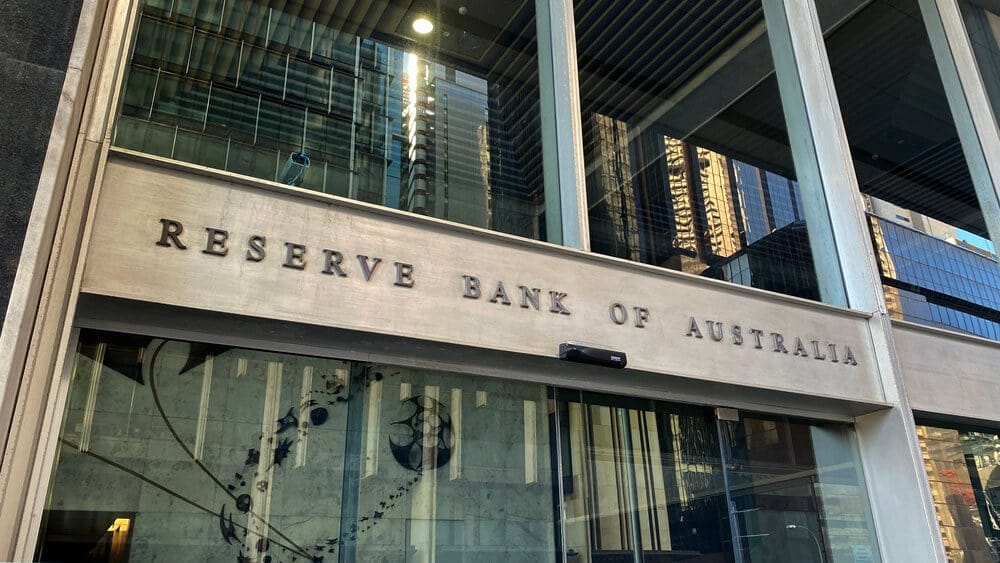
Speakers from the Federal Reserve, primarily Mary Daly and Susan Collins of the Boston and San Francisco Feds, took a cautious tone. Despite not ruling out another rate hike, both emphasised that the Fed should exercise patience with its monetary policy. Austan Goolsbee, the president of the Chicago Fed, recently stated that while a soft landing is feasible, the likelihood of inflation still leans upward. When the Reserve Bank of Australia Conference on inflation is released, traders of the AUDUSD pair will be watching the Australian economic agenda for inspiration. The docket would include housing data, the CB Consumer Confidence, and the S&P/Case-Shiller Home Prices on the US front.
Don’t trade all the time, trade forex only at the confirmed trade setups.
Get Live Free Signals now: forexgdp.com/forex-signals/

